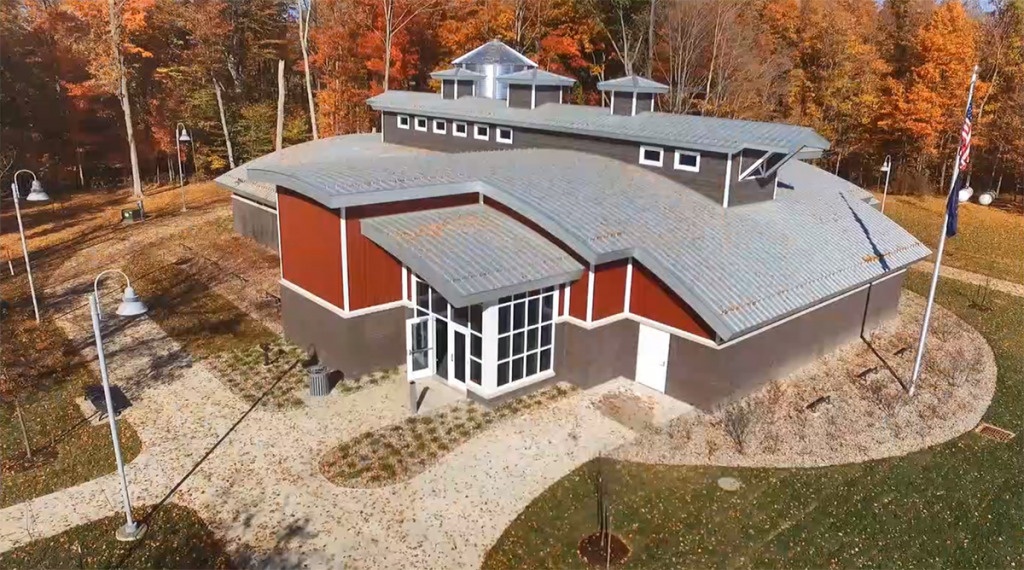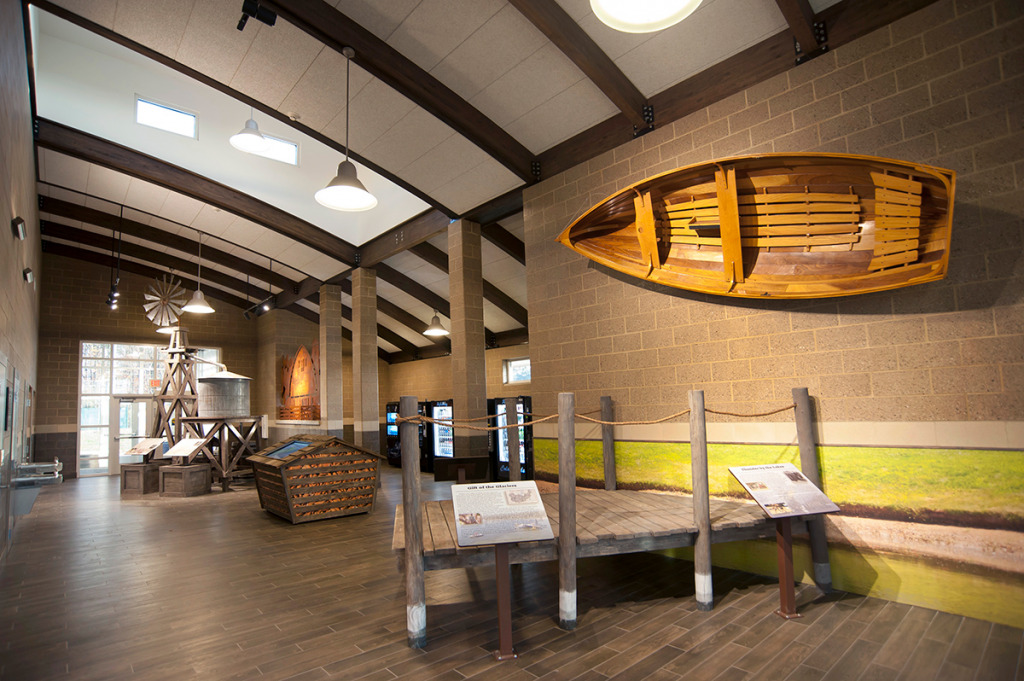Subscriber Benefit
As a subscriber you can listen to articles at work, in the car, or while you work out. Subscribe NowIndiana has launched a 10-year, $275 million effort to improve the state’s image—especially visitors’ first impressions—by overhauling 16 interstate rest stops, including 10 that are welcome centers at the state’s borders.
Already, work is completed on the Pigeon Creek Welcome Center on Interstate 69 near Angola.

And construction began this month on a second rest area overhaul, this one at Kankakee along Interstate 65 in Jasper County.
The latest project will replace a nearly 40-year-old facility, which—like so many of Indiana’s rest stop facilities—has exceeded its ideal life span, state officials said. The new complexes will include modern restrooms and other indoor facilities, as well as outdoor areas like walking trails, picnic spaces and outdoor shelters.
The welcome centers, which will be developed and built by the Indiana Department of Transportation, will feature area-specific design features and exhibits intended to entice out-of-state travelers to visit regional attractions, including state parks.
The Pigeon Creek project cost $7.5 million and includes nods to the area’s lakes as well as to nearby Pokagon State Park.

“Welcome Centers many times provide our visitors with a first impression of Indiana,” Indiana Destination Development Corp. Secretary Elaine Bedel told IBJ in a statement. “The centers are our opportunity to put our best foot forward, and the stunning new welcome centers will do just that. The interactive displays highlighting the state’s history, culture, and quality of life are a great addition for showcasing Indiana.”
The average cost of a welcome center rebuild is expected to be $20 million, depending on the footprint and size of the property, INDOT officials said. New buildings and additional parking spaces will be part of each welcome center project. Money for the projects will come from both federal and state highway funds—and state officials say the 10-year plan is fully funded.
The effort traces back to 2017, when INDOT conducted an audit of its road facilities and determined the improvements were needed. Over the next couple of years, the agency studied the options by considering both operation and maintenance costs as well as capital construction needs and costs. Traffic volumes for the centers helped set the timeline for the projects, including which centers to focus on initially.

INDOT Deputy Chief of Staff Scott Manning said the biggest need is for an overall modernization of the facilities—and the hope is that improved restrooms and parking spaces, along with outdoor recreation areas, will encourage more travelers to stop.
As in many states, there’s been some clamoring for improvements to Indiana’s rest stops.
“Could someone please invest some money into the rest areas along our Indiana interstate highway system?” John Patten of Indianapolis recently said in a comment about an IBJ story on increased funding for state parks. “For visitors from other parts of our country, along with residents traveling to state parks and other destinations, these are beyond embarrassing!”
A post in the Reddit community r/Indiana titled “Indiana Rest Areas … an embarrassment for Hoosier Hospitality” has 67 comments. And Yelp even offers rest stop reviews, with reactions to Indiana’s stops mixed.
Manning said the state’s goal is to give all travelers a good experience when they need to make a pit stop—and perhaps encourage them to check out some sites in the area.
“When people travel across those state lines, these are often the first opportunity to exit,” he said. “Our hope is these facilities will convince some to stop in and even take part of local attractions, whether it be restaurants or cultural things.”
As part of the projects, the state is expanding the amount of truck parking statewide to address a shortage. Currently, the state’s rest areas feature about 1,100 truck parking spaces. After the rest stop revamps, that number will increase to more than 2,500.
That’s good news for long-haul truckers, said Barbara Smithers, vice president of the Indiana Motor Truck Association.
“Anytime there’s an addition of parking spaces, truckers are going to see benefits,” she said. “We need increased truck parking and we’re happy with INDOT’s decision to upgrade these facilities.”
Smithers also said providing recreation areas—such as walking trails—at the sites will provide commercial truck drivers with better options for their break times.

State officials plan to expand Indiana’s truck parking information management system to the new welcome centers and updated rest areas. The platform tracks parking availability at each facility and displays the information on signs placed across Indiana’s interstates, which remain some of the busiest truck corridors in the country.
The U.S. Department of Transportation defines major freight corridors as “highway segments that carry at least 8,500 trucks per day.” All of Indiana’s interstates have segments that fit the designation.
“We see millions of commercial miles traveled a day on our state’s highway system,” Manning said. “Freight traffic is expected to grow 40% in the next 20 years, so we need to be able to accommodate that growing need.”
Construction of a truck parking facility in Martinsville, as well as a new rest facility at Crane, will be part of the 10-year project. Both will be along sections of Interstate 69, which remains under construction from Martinsville to Indianapolis.•
Please enable JavaScript to view this content.

Nobody is going to stop at a welcome center if you can’t get gas and food. Our welcome centers need to be commercialized of we want people to actually go to them.
Exactly. People who drive long distances (I drove about 6,000 miles across 19 states this summer) stop for gas, food, and lodging on long hauls; all those stops have restrooms. I spent time at exactly one rest area: the one on the Bonneville Salt Flats.
.
And in 2021, information about things to do and nearby attractions is readily available on map/travel apps. Building mini-museums seems like a waste of money. Ads on AccuWeather and Facebook would probably produce more measurable results.
Maybe I’m now crazy because I live out West, but our rest areas here are atrocious compared to Indiana. California doesn’t even have A/C in our rest areas. It’s completely unacceptable. Indiana has bad rest areas, but I don’t see the need to commercialize them. Almost every interstate in Indiana has a gas station nearby any rest stop. You don’t actually need them. If I just need to pee, it is more convenient to stop at a rest stop than a gas station. There’s less traffic and you go in and out quickly. Adding businesses would decrease the convenience of the traditional rest stop, in my opinion. Coffee/vending machines would be nice, but once again, Indiana has enough gas stations and other things to stop at. The California/Arizona desert does not.
Pretty certain the feds don’t allow rest areas to be commercialized, with the small exception for vending machines. They don’t want people loitering, queuing lines for services. It is supposed to be an area to get out, use the facilities, and get back on the road for the average road user.
The PA and OH Turnpikes, which predate the Interstate Highway System, do have commercial rest areas.
Does seem like a pretty poor use of the money for the benefits. Throw in a couple dozen electric car chargers at each stop, with a basic cafe, and you might have a winner.
Whoops. Should have done my homework. Looks like there are archaic federal rules against that idea…
https://www.utilitydive.com/news/NATSO-commercialization-interstate-rest-stop-electric-charging/595838/
Indiana has closed and knocked down several rest areas over the last decade. If there’s a truck stop or gas station nearby, Indiana prefers that you go there than visit a rest area.
We get what we pay for, Hoosiers…
Seems ludicrous to spend $20 million per on a place few people would ever visit. People don’t form an opinion about a state based on the rest stop.
As we travel South to Florida several times a year, we note how much nicer the rest areas are in all of the states we pass through. They are extremely attractive, neat and clean. It is discouraging to compare these to the ones in Indiana. We have neglected these for way too long, and as the article notes they certainly don’t entice anyone to stop and give a negative feeling of our great state.
They need a cleanup, upgrade, and proper attention to aesthetics.
This is a urgent need. I stopped at the rest stop on 65 south just north of the 149 mile marker. The grass was so long the place looked abandoned and the inside of the building was honestly one step above an outhouse. I’m all in on the efforts of the new IDDC, but INDOT needs to step it up. I’ve never been in a rest stop for any state that was as bad as this one. Sorry for negative comments but please do something!
The last time I visited a rest stop in Indiana I was approached by a very pregnant and very drug addicted woman who asked me for money. I don’t know why it made me so sad, but it did. We just stop at gas stations now.
Indiana has a long history of poor investment in infrastructure. Toll facilities with rest stops and fuel services are attractive despite the tolls. However, strategically spaced rest stops along interstates and other highlight used highways is a benefit to travelers for reasons such as a pit stop, rest to avoid fatigue, exercise, etc. Considering the age and poor condition of some (read: most) Indiana facilities, an investment for for next 50 years seems worthwhile. But the number and location of rest stops should identified based on anticipated use, nearby facilities, and potential to provide essential or beneficial information for travel, safety, or Indiana [revenue generating] tourism or activities.
The main issue in Indiana is that we don’t maintain infrastructure properly after it’s built. We just tear it down and build new, but that’s what happens when we cheap out on the initial design/build.
Recreation areas? How about some child and adult play equipment to burn some pent-up energy after a long ride in a car.
“including 10 that are welcome centers at the state’s borders” I only count 8 interstate entrances to Indiana. Where are the other 2?
I count several more than that… clockwise from Lake Michigan:
I-94 @ Michigan City
I-69 @ Angola
I-90 @ Angola
I-70 @ Richmond
I-74 @ (Cincinnati)
I-65 @ Jeffersonville
I-44 @ New Albany
I-69 @ Evansville
I-64 @ Evansville
I 70 @ Terre Haute
I-74 @ Covington
I-94 @ Hammond
I-90 @ Gary
Thats 13 interstate entrances to Indiana, not counting I-275 by Cincinnati, that goes in- and- out of the state for a few miles.
(typo I-64 @ New Albany)
I for one use rest areas when I travel and use regular exits only when I stop for gas. I pack a cooler and appreciate the convenience of rest areas. Thanks for the upgrades.
Comments like “poor use of money” and generalizations about “people only stopping for food and gas” and the need to “commercialize rest areas” are clearly out of touch. First, our interstate system connects our country. It connects our states both intra and inter. For those coming into our State, these waypoints should be elements that speak to our Hoosier heritage and pride. In the same way that we welcome people into our home, I don’t see a rest area as any different. For those traveling within the State, I’m not on a long-haul or traveling to some distance place. Having a clean, inviting rest area along our interstate systems is welcomed regardless of nature’s call or the need to rest.
Add to this the safety needs of our long haul drivers transporting goods throughout our country. These rest areas are needed to ensure a stopping place. I don’t recall ever seeing a rest area that is absent a trucker.
In the end, I am so happy to hear about this major investment. It will benefit tourism within our State, it will provide pride for all Hoosiers, it will show other states that we are proud of our Hoosier Heritage and want to share that message with anyone who travels the Indiana interstate system and, perhaps most importantly, the safety of rest while traveling, even if for a short period.
Well-spoken, John P. Thumbs-up.
To those comments asking about the commercialization of rest stops – See below…
States that receive Federal-aid for their NHS highway facilities or who wish to maintain eligibility to receive it must adhere to applicable Federal statutes and regulations. Section 111, of Title 23, United States Code, and 23 CFR 752.5 prohibit over-the-counter sales of merchandise in rest areas located on the Interstate. Allowable commercial activity in rest areas on the Interstate System includes:
Installation of commercial advertising and media displays, if such advertising and displays are exhibited solely within any facility constructed in the rest area and are not legible from the main traveled way;
sale of items designed to promote tourism in the State, limited to books, DVDs, and other media;
sale of tickets for events or attractions in the State of a historical or tourism-related nature;
distribution of travel-related information, including maps, travel booklets, and hotel coupon booklets;
installation and operation of lottery machines;
and installation and operation of vending machines which may only dispense such food, drink, and other articles as the State transportation department determines are appropriate and desirable and which are operated in accordance with the Randolph-Sheppard Act of 1936 found at 20 U.S.C. 107.
20 million dollars? Roadside museum? I think we have many more small town and inner city needs throughout the state that would benefit CONSIDERABLY more.
No question OUT OF TOUCH government.